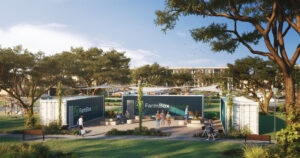It’s clear that emerging technologies will and are playing an increasingly vital role in how we live our lives and how we conduct business.
The advent of AI-driven everything marks a turning point in society. But it’s worth noting that technology has been transforming our day-to-day for centuries, albeit in different forms. The printing press was a game-changer for information sharing. Television built upon what radio had already started. Mechanized implements turned traditional farming on its head. Now, technology exists to enable people to grow food in places where it’s never been possible. 
FarmBox Foods leverages its modular container farms to allow others to sustainably feed people, transforming standard 40-foot shipping containers (approximately 320 sq. ft.) into fully automated farms. These container units are climate‑controlled, sensor‑driven and — in the case of the Vertical Hydroponic Farm — stacked with vertical tubes to maximize yield per square foot, with integrated LED lighting and nutrient delivery systems supporting year‑round cultivation of leafy greens, herbs, peppers and more.
At the heart of the technology is a patented vertical hydroponic watering system, capable of reducing water usage by up to 99% compared to traditional agriculture. By cycling nutrient-rich water through seed tables and grow tubes, and tightly controlling environmental variables, FarmBox eliminates the need for pesticides or fertilizers, enabling the production of fresh, clean produce that can reach vulnerable populations with minimal contamination risk.
FarmBox also created a farm to grow nutrient-dense mushrooms. The mushroom unit yields around 400 lbs. per week, often across multiple specialty species. The fodder systems can produce 850 lbs. per day of high‑digestibility feed supplement for livestock, improving animal health and reducing methane emissions, a further benefit for sustainability and local protein supply.
A core component of our mission is deploying these container farms directly into food deserts, remote communities, schools, hospitals, underutilized urban spaces, prisons, farms and ranches, and food banks. By placing farms in or near populated, underserved areas, FarmBox dramatically reduces transportation delays, minimizes spoilage and provides locally grown produce on demand, boosting both food security and access.
Through smart, compact, water‑efficient container farms that can operate nearly anywhere, FarmBox Foods is bringing fresh food production to the front lines of food insecurity, feeding people in need with local, predictable, healthy and safe harvests year‑round.



